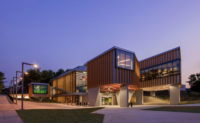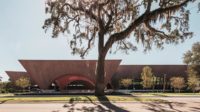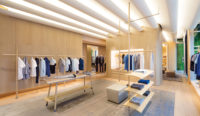Francis Gregory Library by Adjaye Associates
Washington, DC












Architects & Firms
With the Gregory library, Adjaye has created a shimmering pavilion at the edge of Fort Davis Park in the southeastern part of the city. The two-story, steel-frame structure, 23,000 square feet in size, both blends in with its wooded surroundings and distinctively stands out from them by virtue of its sleek, glass-enclosed, 24-foot-high volume tucked underneath a muscular, louvered aluminum canopy. Floating above the pavilion, the dark-gray canopy brings the library's height to 35 feet and bolsters its commanding presence in the neighborhood. In addition, it cantilevers 20 feet from the south entrance facade to provide a needed sunshade in the summer.
A diamond motif characterizes the library's curtain wall where the glass lites vary in width from 5 to 8 feet'an 'expansion and contraction that reflects the notion of growth, like the forest,' says Adjaye. Just behind the limpid glass exterior surface, an open web of diamond-shaped plywood modules subtly asserts its presence on the outside. The modules, 1 foot 3 inches deep, contain the actual structure of the curtain wall'an X-shaped steel diagrid next to the glass with vertical steel supports backing it up. The exterior glass that skims by the plywood modules in this seemingly effortless structural exercise alternates between low-E, double-insulated panes allowing views out and spandrel panels with a mirrored finish on the inner surface that reflects the leafy trees. Where access to the library is needed, such as at the entrance on one end of the south facade, Adjaye has inserted portals of composite metal panels into the curtain wall'one of the few gestures that interrupt the strong concept of the luminously abstract glass pavilion.
The glossy facade is a clue to the combination of simplicity and complexity integral to the architect's approach. This can be seen not only in the exterior planes and structure but in the interior's spatial disposition and functional resolution, as well as the overall play of colors and textures. Visitors enter a lobby of gleaming black surfaces: The circulation desk features a base of lacquered black medium-density fiberboard (MDF) topped by a solid-surface black counter. Along with the black-stained concrete floor and a 13-foot-high soffit of drywall with a bronze metallic finish, the architect has established a dramatic counterpoint to the skylit main hall extending along the south facade. Here the space soars upward to a 23-foot-high skylight composed of a diagrid of aluminum and glass. Freestanding shelves for electronic media edge the open-plan ground-floor reading areas, where one can also catch framed glimpses of the park in back.
Visitors can take the angular black stair, or elevators in either of two service cores, to the second floor. Here the children's reading and other areas extend toward the perimeter of the library's volume. Although these areas are enclosed by interior walls, deep windows with seats carved into them allow children to read while looking into the woods through clear diamond panes in the exterior walls beyond. If the acoustical ceiling of the children's browsing room seems rather low, the occasional skylight adds much-desired natural illumination. Also on this floor, a semi-enclosed comma-shaped space clad in Douglas fir functions as a children's program room, and a conference room with a large glass interior window overlooks the double-height teen reading room.
The architects attained a LEED Silver rating: The glass walls promote thermal gain during the winter, but the canopy cuts unwanted solar load in the summer. In addition, the ground paving is pervious to prevent storm runoff. (Yet the subzero air conditioning on a hot summer day is a reminder that LEED ratings do not guarantee energy-efficient operations.)
With a budget of $13 million, Adjaye has managed to give the branch library an unusual sense of elegance and sumptuousness, while still imparting a visual and physical accessibility to its neighborhood users. A break-in connected with theft of computer goods caused damage to the glass, yet, according to Ginnie Cooper, the DCPL's chief librarian, the community has been 'warmly responsive' to its design. Many find it 'jaw-dropping.'
Location:
3660 Alabama Avenue, SE
Washington, DC
Total construction cost: $13 million
Completion date: June 2012
Size: 23,000 square feet
PeopleOwner: District of Columbia Public Libraries
Architect: Adjaye Associates Personnel in architect's firm who should receive special credit:
Architect of record: Wiencek + Associates
Engineer(s): MEP:Setty & Associates International Structural:ReStl Designers
Consultant(s): Landscape: Greenhorne & O’Mara
Owner’s Representative: Jair Lynch Development Partners
General contractor: Hess Construction (mentor construction manager)
Photographer(s): Edmund Summers
CAD system, project management, or other software used: Autocad 2010 |
ProductsStructural system Steel Frame
Exterior cladding Metal/glass curtain wall: Custom: Tower Glass Company, Woburn MA Louvered Canopy: Custom: Conservatek Industries, INC. Glazing:
Doors Entrances: Dorma
Interior finishes Acoustical ceilings: Ecophan Cabinetwork and custom woodwork: Custom: ISEC, Inc Plastic laminate: Mirror: Decatone Colors: Abet Laminati Floors: Stained and Polished Concrete Carpet: Mannington
Furnishings Office furniture: Herman Miller ReadingTables:Vitra Seating: Herman Miller Chairs lounge:Bernhardt Shelving: Space Saver
Conveyance Elevators/Escalators: Kone |













